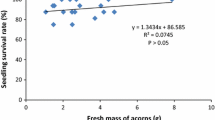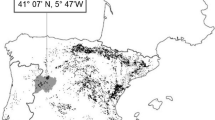Abstract
Key message
Embryonic axes of acorns have greater variability of mass than cotyledons or pericarp. Above/below ground seedling mass depends on oak species.
Abstract
Species of the genus oak are of great importance for forest ecosystems in almost all of the Holarctic. Knowledge of the diversity of the size of acorns and their parts would allow better use of the opportunity of genetic resources storage, both for the protection of endangered oak species and for forestry practices. The initial development of seedlings in reference to the size of the acorn, its parts and acorn maturation time was also investigated. The fresh and dry mass of individual acorns, embryonic axes and cotyledons of 15 species (Quercus agrifolia, Q. gambelli, Q. kelloggii, Q. alba, Q. bicolor, Q. coccinea, Q. falcata, Q. lyrata, Q. nigra, Q. prinus, Q. rubra, Q. cerris, Q. ilex, Q. petraea, and Q. robur) were determined. In the second part of the study, the mass of the ca. 3-month-old seedlings that had completed the first stage of growth, with a division on the leaves, the shoot and the root, was measured. The greatest variation in mass both between and within the species was demonstrated for the embryonic axis. The mass of seedlings depends on the size of the acorn and the cotyledons contained therein; whereas, the mass of the embryonic axis has no significant influence on the mass of seedlings.




Similar content being viewed by others
References
Aizen MA, Patterson WA (1990) Acorn size and geographical range in the North-American oaks (Quercus L.). J Biogeogr 17:327–332
Andersson C, Frost I (1996) Growth of Quercus robur seedlings after experimental grazing and cotyledon removal. Acta Bot Neerl 45:85–94
Bakis Y, Babac MT (2014) Morphological variability of acorns and its taxonomic significance in Quercus L. from Turkey, Bangladesh. J Bot 43:293–299
Bartlow AW, Agosta SJ, Curtis R, Yi XF, Steele MA (2018) Acorn size and tolerance to seed predators: the multiple roles of acorns as food for seed predators, fruit for dispersal and fuel for growth. Integr Zool 13:251–266
Barzdajn W (2002) The variability of dimensions of Quercus robur L. and Quercus petraea (Matt.) Liebl. acorns in Poland. Dendrobiology 47:s21–s24
Bonito A, Varone L, Gratani L (2011) Relationship between acorn size and seedling morphological and physiological traits of Quercus ilex L. from different climates. Photosynthetica 49:75–86
Bonner FT (1996) Responses to drying of recalcitrant seeds of Quercus nigra L. Ann Bot 78:181–187
Bonner FT (2008) Quercus L. Oak. In: Bonner FT, Karrfalt RP, Nisley RG (eds) The woody plant seed manual, vol 727. USDA Forest Service, Washington DC, pp 928–938
Bonner FT, Vozzo JA (1987) Seed biology and technology of Quercus. US Dept of Agriculture, Forest Service, Southern Forest Experiment Station, New Orleans
Branco M, Branco C, Merouani H, Almeida MH (2002) Germination success, survival and seedling vigour of Quercus suber acorns in relation to insect damage. For Ecol Manag 166:159–164
Callaway RM (1992) Morphological and physiological-responses of three California oak species to shade. Int J Plant Sci 153:434–441
Castro J (1999) Seed mass versus seedling performance in Scots pine: a maternally dependent trait. New Phytol 144:153–161
Clark SL, Schlarbaum SE (2018) Effects of acorn size and mass on seedling quality of northern red oak (Quercus rubra). New For 49:571–583
Connor KF, Bonner FT, Vozzo JA (1996) Effects of desiccation on temperate recalcitrant seeds: differential scanning calorimetry, gas chromatography, electron microscopy, and moisture studies on Quercus nigra and Quercus alba. Can J For Res 26:1813–1821
Denk T, Grimm GW, Manos PS, Deng M, Hipp AL (2017) An updated infrageneric classification of the oaks: review of previous taxonomic schemes and synthesis of evolutionary patterns. In: Gil-Pelegrín E, Peguero-Pina JJ (eds) Oaks physiological ecology. Exploring the functional diversity of genus Quercus L. Springer, Berlin, pp 13–38
Dodd RS, Rafii ZA, Zavarin E (1993) Chemosystematic variation in acorn fatty-acids of californian live oaks (Quercus agrifolia and Q. wislizenii). Biochem Syst Ecol 21:279–285
Finch-Savage WE (1992) Embryo water status and survival in the recalcitrant species Quercus robur L.: evidence for a critical moisture content. J Exp Bot 43:663–669
Garcia-Cebrian F, Esteso-Martinez J, Gil-Pelegrin E (2003) Influence of cotyledon removal on early seedling growth in Quercus robur L. Ann For Sci 60:69–73
Giertych MJ, Suszka J (2011) Consequences of cutting off distal ends of cotyledons of Quercus robur acorns before sowing. Ann For Sci 68:433–442
Gomez JM (2004) Bigger is not always better: conflicting selective pressures on seed size in Quercus ilex. Evolution 58:71–80
Gonzalez-Rodriguez V, Villar R, Navarro-Cerrillo RM (2011) Maternal influences on seed mass effect and initial seedling growth in four Quercus species. Acta Oecol 37:1–9
Harmer R (1990) Relation of shoot growth phases in seedling oak to development of the tap root, lateral roots and fine root-tips. New Phytol 115:23–27
Howe HF, Richter WM (1982) Effects of seed size on seedling size in Virola surinamensis; a within and between tree analysis. Oecologia 53:347–351
Iakovoglou V, Misra MK, Hall RB, Knapp AD (2007) The effect of seed size and parent tree on seed variables and seedling growth of Quercus macrocarpa and Q. alba. Seed Sci Technol 35:771–777
Ivankovic M, Popovic M, Bogdan S (2011) Acorn morphometric traits and seedling heights variation of pedunculate oak (Quercus robur L.) from the seed stands in Croatia. Sumar List 135:46–58
Kennedy PG, Hausmann NJ, Wenk EH, Dawson TE (2004) The importance of seed reserves for seedling performance: an integrated approach using morphological, physiological, and stable isotope techniques. Oecologia 141:547–554
Landergott U, Gugerli F, Hoebee SE, Finkeldey R, Holderegger R (2012) Effects of seed mass on seedling height and competition in European white oaks. Flora 207:721–725
Mabberley DJ (2008) Mabberley’s plant-book: a portable dictionary of plants, their classification and uses. Cambridge University Press, Cambridge
Merouani H, Apolinário LM, Almeida MH, Pereira JS (2003) Morphological and physiological maturation of acorns of cork oak (Quercus suber L.). Seed Sci Technol 31:111–124
Munoz A, Bonal R, Espelta JM (2012) Responses of a scatter-hoarding rodent to seed morphology: links between seed choices and seed variability. Anim Behav 84:1435–1442
Perea R, San Miguel A, Martínez-Jauregui M, Valbuena-Carabaña M, Gil L (2012) Effects of seed quality and seed location on the removal of acorns and beechnuts. Eur J For Res 131:623–631
Perez-Ramos IM, Gomez-Aparicio L, Villar R, Garcia LV, Maranon T (2010) Seedling growth and morphology of three oak species along field resource gradients and seed mass variation: a seedling age-dependent response. J Veg Sci 21:419–437
Pons J, Pausas JG (2007) Not only size matters: acorn selection by the European jay (Garrulus glandarius). Acta Oecol 31:353–360
Ramírez-Valiente JA, Valladares F, Gil L, Aranda I (2009) Population differences in juvenile survival under increasing drought are mediated by seed size in Cork oak (Quercus suber, L.). For Ecol Manag 257:1676–1683
Rodríguez-Calcerrada J, Nanos N, Aranda I (2011) The relevance of seed size in modulating leaf physiology and early plant performance in two tree species. Trees 25:873–884
Sage RD, Koenig WD, McLaughlin BC (2011) Fitness consequences of seed size in the valley oak Quercus lobata Née (Fagaceae). Ann For Sci 68:477–484
Sánchez-Montes de Oca EJ, Badano EI, Silva-Alvarado LE, Flores J, Barragán-Torres F, Flores-Cano JAJAoFS (2018) Acorn weight as determinant of germination in red and white oaks: evidences from a common-garden greenhouse experiment. Ann For Sci 75:12
Shi WH, Villar-Salvador P, Li GL, Jiang XX (2019) Acorn size is more important than nursery fertilization for outplanting performance of Quercus variabilis container seedlings. Ann For Sci 76:12
Sobrino-Vesperinas E, Viviani AB (2000) Pericarp micromorphology and dehydration characteristics of Quercus suber L. acorns. Seed Sci Res 10:401–407
Suszka B, Muller C, Bonnet-Masimbert M (1996) Seeds of forest broad leaves: from sowing to harvest. INRA Editions, Paris
Westoby M, Leishman M, Lord J (1996) Comparative ecology of seed size and dispersal. Philos Trans R Soc Lond B 351:1309–1317
Wrobel A, Zwolak R (2017) Deciphering the effects of disperser assemblages and seed mass on patterns of seed dispersal in a rodent community. Integr Zool 12:457–467
Xia K, Seal CE, Chen WY, Zhou ZK, Pritchard HW (2010) Fruit oil contents of the genus Quercus (Fagaceae): a comparative study on acorns of subgenus Quercus and the Asian subgenus Cyclobalanopsis. Seed Sci Technol 38:136–145
Xia K, Daws MI, Stuppy W, Zhou ZK, Pritchard HW (2012) Rates of water loss and uptake in recalcitrant fruits of Quercus species are determined by pericarp anatomy. PLoS One 7:11
Yi XF, Wang ZY (2016) The importance of cotyledons for early-stage oak seedlings under different nutrient levels: a multi-species study. J Plant Growth Regul 35:183–189
Yi X, Wang Z, Liu C, Liu G, Zhang M (2015) Acorn cotyledons are larger than their seedlings’; need: evidence from artificial cutting experiments. Sci Rep 5:8112
Acknowledgements
We are indebted to Marcin Michalak, Magdalena Sobczak, Agata Obarska and Paulina Pilarz for technical help. We would like to thank American Journal Experts for linguistic revision of the manuscript. This research was financially supported by statutory funding from the Institute of Dendrology (Polish Academy of Sciences).
Author information
Authors and Affiliations
Corresponding author
Additional information
Communicated by J. Hormaza.
Publisher's Note
Springer Nature remains neutral with regard to jurisdictional claims in published maps and institutional affiliations.
Electronic supplementary material
Below is the link to the electronic supplementary material.
Rights and permissions
About this article
Cite this article
Giertych, M.J., Chmielarz, P. Size variability in embryonic axes, cotyledons, acorns and seedlings in fifteen species of the genus Quercus. Trees 34, 593–601 (2020). https://doi.org/10.1007/s00468-019-01941-3
Received:
Accepted:
Published:
Issue Date:
DOI: https://doi.org/10.1007/s00468-019-01941-3




